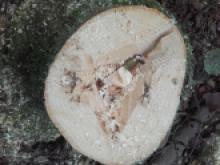A couple of weeks ago the volunteers and I joined staff and volunteers from Severn Trent Water to carry out some woodland management on their site at Tittesworth. The work was in aid of three areas of the woodland’s ecology.
Firstly: willow tits. These rare little birds have declined by over 90% since the mid 1970’s and have become extinct in certain areas of the country where they used to be very common. One of the reasons for this decline is thought to be their very specific nesting requirements – they hollow out rotting tree stumps that are about 5 feet high and no more than a foot across – very specific! The stumps have to be soft and well rotted because these little birds don’t have the same power as something like a woodpecker and therefore can’t excavate solid wood. A lot of woodland is now “tidied” by its owners and so these stumps are often removed leaving the willow tits with few places to nest.
By thinning the woodland we helped to create the correct canopy conditions and leaving the stumps of the trees nice and high means that, after we’ve ring barked them, they’ll die and begin to rot forming the perfect home for willow tits to raise their chicks.
Secondly: veteran lime trees. The woodland we worked in was also home to some rather old lime trees. As those of you who’ve read my previous blogs on veteran trees will know, older trees have wildlife value that cannot be replaced by younger trees – they have rot holes and hollows full of insects, they are home to a wide range of fungi and have carpets of rare mosses and lichens growing on them while nooks and crannies in the bark and their root bases provide homes for bats and other mammals. So it’s really important to keep these old trees as healthy as possible so we don’t lose them and have to wait another century before they can be replaced.
So thinning the canopy around these lime trees as part of the more general thinning of this wood helps give them light and reduce competition for water and nutrients from surrounding trees. This keeps these old veterans alive for future generations to enjoy.
Thirdly: saproxylic invertibrates. Don’t worry “saproxylic” sounds a little complex but all it means is an organism that relies on dead wood in some way. That might be for food, for nesting habitat, or for shelter during hibernation. Many species of saproxylic insects are becoming rarer as we continue to tidy our woodland and remove dead and decaying trees.
While we were thinning the wood we also left what are called stump wells, or artificial rot holes. These are created by boring into the stumps of the fallen tree with a chainsaw creating a small bowl. This is then filled with wood shaving and other detritus which, as the well fills with rainwater, begins to rot and forms perfect habitat for certain rare insect larvae. When the larvae mature they will fly out into the woodland and provide food for the larger animals there.
Overall it was great day and really good to see the two groups work closely together and really get stuck in. It was also positive to see everybody’s interest in the wildlife we were helping to preserve.



